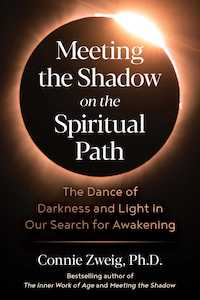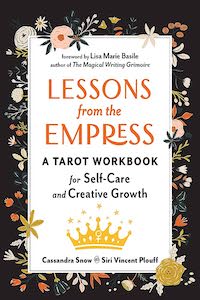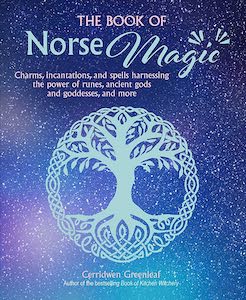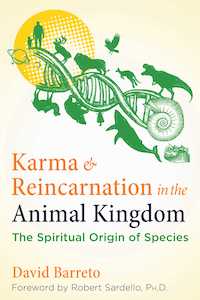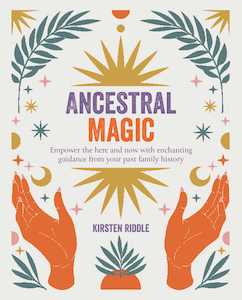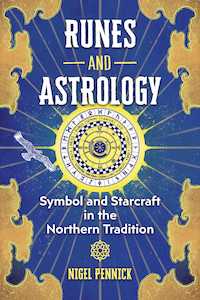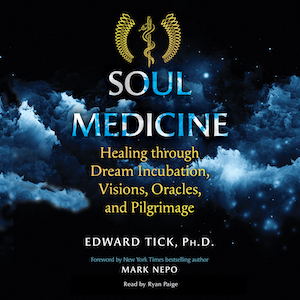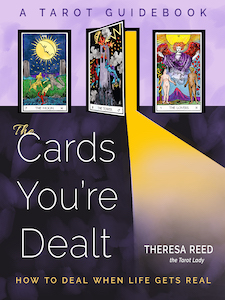
The Cards You’re Dealt: How to Deal When Life Gets Real, by Theresa Reed
Red Wheel Weiser, 9781578638031, 240 pages, October 2023
After following Theresa Reed, AKA “The Tarot Lady” for a number of years, I was thrilled to see The Cards You’re Dealt! The title was intriguing and her reputation as both reader and teacher is stellar. This book did not disappoint. From the first page of her preface on “The Death Cards,” I was drawn in, knowing that along with knowledge I would receive keys to healing as well. Reed’s introduction sets the tone and lights the way for the book, explaining how to use the book, what it covers, and tips to make the most of it.
Reed has over thirty years’ experience reading tarot for clients and is widely known as an expert, speaker, and teacher in tarot. She is host of an online podcast on tarot called Tarot Bytes, as well as Astrology Bytes which features short pieces on astrology. She has written four other books, as well as co-authored a book with Shaheen Miro. (One of my favorite books by Reed is her book Astrology for Real Life.) Her website is https://www.thetarotlady.com/, and she currently resides in Milwaukee, Wisconsin.
This book interested me because of the wide range of questions I get from clients regarding their lives. When I skimmed the table of contents, I knew that Reed was sharing great information for handling the sensitive subjects of life. Reed shares:
“As I said before, the topic is heavy, but this book is full of hope…. This book is balm for the soul when you’re overwhelmed and need to find solace, healing, and compassion for yourself or others.”1
The book is structured in an easy-to-navigate style with a complete table of contents that takes you through the basics of tarot to the Major and Minor Arcana and on to a wide array of tarot spreads. In the section on tarot basics, Reed covers a brief history, how to buy your first deck, what’s inside a deck, myths and misconceptions, and how to do a reading. I particularly love her sections called “Words to the Wise” and “Some Tarot Do’s and Don’ts”. Here’s one of my favorites:
“Do not worry about being wrong or right. This desire will create rigidity or trepidation in your readings. There will always be times when you see clearly and other times when the messages are murky. Do your best.”2
Many people who want a tarot reading struggle with asking the “right” question. Reed has several ideas, including ways to reframe a question to allow the divination tool to share more helpful guidance.
Next, Reed shares information and interpretations for the Major Arcana followed by the Minor Arcana cards. She uses the Rider-Waite-Smith cards for her guide and references the traditional symbolism for each card. Although she references her more than thirty years reading with the cards, she asks everyone to trust their own wisdom when interpreting the cards. Early in the book, she references that it is personal preference whether you read reversals or not. Yet, she includes reversed meanings for each card, as well as a journaling prompt and a practice prompt, which asks for a comparison of the card message to personal experience.
She also gives what she calls a “Pro Tip” for each Major Arcana card and the King cards in the Minor Arcana. This tip takes the overall message from that card and creates a suggestion for the reader to use to improve reading skill, intuition and overall divination abilities. Here’s an example of the Pro Tip from the Chariot:
“The only way to get good at Tarot is constant practice period, not just reading your own daily card, but also reading for as many folks as you can. The more people you read for, the more likely you’ll encounter various situations that will stretch your intuitive muscles and tarot interpretations!3
For the Minor Arcana, Reed does a complete review of the four suits, the court cards, and the numbers (from Ace to 10). She also includes a practice exercise and a pro tip in this section, which precedes the individual card meanings.
Then, in Part Two, Reed adds seven different sections on various life topics, including extensive information on losses. Here, it gets really interesting, as Reed takes you through various spreads for guidance. My favorite spread was the Recovery Spread. Reed shares how to use just three cards to provide guidance for someone who may be recovering from surgery, illness or chemotherapy. Here is the simple layout from page 116:
Card 1: Present moment
Card 2: What do I need right now?
Card 3: How can I continue to support my healing?
She gives an example from her client files and the reader can easily see how the spread works for this issue.
I decided to try it myself, as I was recovering from a brief illness. The cards I drew were:
1. The Tower: Yes, there’s some chaos and upheaval
2. King of Pentacles: A need to balance a time to rest with anything that needs to be done right now. Use your good judgment to plan the next few days, so you can rest.
3. Knight of Wands: Focus your energy where it is really needed and don’t waste it on burning out!
Sage advice for me, as a person who is always moving!
I also enjoyed her spread on Meeting My Guardian Angel and the section “Creating Spreads Through Conversation”. Rarely do all readings fit a prescribed tarot spread. Here, Reed gives a way to talk with the person and create questions for the cards in the moment. In this instance, the information relates most to those who are in the last stages of life. The way in which Reed discusses death and dying and working with this type of client is very reverent and compassionate. The information is invaluable to readers. The information she shares on grief is also presented in a kind, helpful manner.
Reed writes in a very conversational style, almost as if you are receiving a reading from her. The book is very easy to navigate, and includes resources on grief, death and mental health, as well as recommended reading on tarot, grief, dying, Buddhism, and yoga at the back of the book.
This book would be a great reference book for someone with a few years’ experience reading tarot, as well as seasoned professionals. With Reed’s guide and earnest practice, even a new reader could really improve their skills with the tips, card meanings and spreads in this resource.
Taking a prominent place in my office, Reed’s book will help me with readings for life’s hard questions and provide guidance for situations that challenge people. Along with the cherished decks I use for client readings, Reed will whisper encouragement to me as a reader, as I do my important work.
As she says on the title page, Reed shares that The Cards You’re Dealt is:
“A tarot guide that’s not about predicting the future but about dealing with and healing from the tough stuff we all face everyday: loss, illness, challenging relationships.”4

PJ Spur is an author, intuitive, spiritual mentor, astrologer, and hypnotist. She does tarot & oracle card readings, natal chart readings, grief coaching, and relationship healing. She also has hosted a weekly “Coffee & Cards” event with her Soul Compass Community for the past four years. Her book Navigating Grief with Grace is available on Amazon. Learn more at www.dearpj.com


